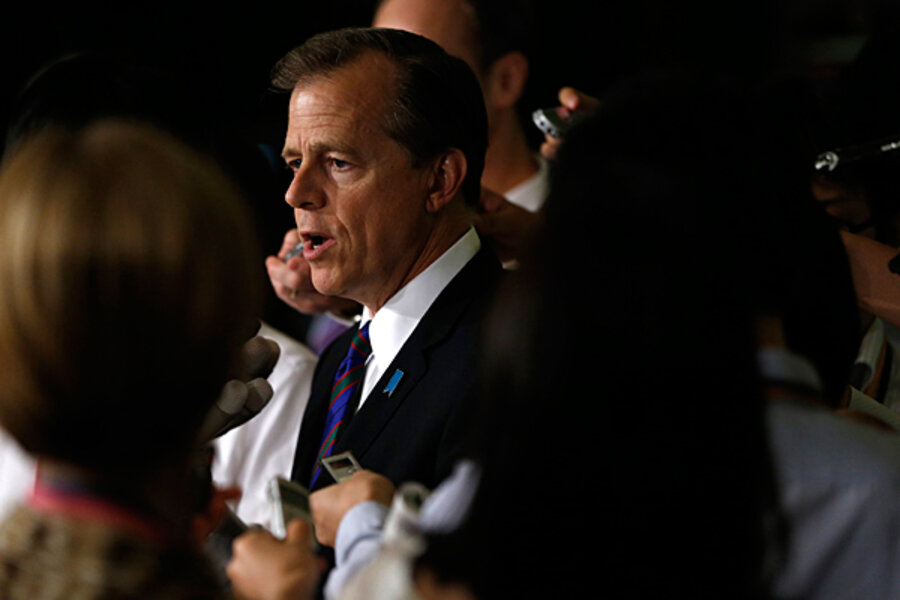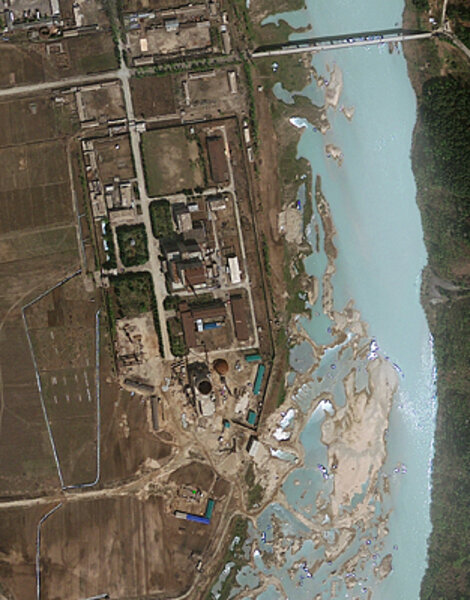North Korea nuclear reactor restart: Why it's a big deal.
Loading...
| Washington
North Korea appears to have restarted the 5 megawatt gas-graphite reactor at its nuclear complex in Yongbyon. Satellite photos from Aug. 31 show steam rising from a building near the reactor hall that houses steam turbines and electric generators, according to a report from the US-Korea Institute at the Johns Hopkins School of Advanced International Studies.
“The white coloration and volume are consistent with steam being vented because the electrical generating system is about to come online, indicating that the reactor is in or nearing operation,” write Nick Hansen of Stanford University and Jeffrey Lewis of the James Martin Center on Nonproliferation on 38 North, the US-Korea Institute’s blog.
This reactor had been off-line since it was shut down in 2007, per international talks aimed at getting Pyongyang to give up its nuclear weapons program. Those negotiations stalled long ago, and North Korea in April said it was going to restart the 5 megawatt reactor, even though it had blown up the cooling tower.
Given that we figured this was coming, is news of the restart still a big deal?
Yes. Yes, it is.
The primary reason for this is that the stakes are high. Once in full operation, which could take several years, the reactor would enable North Korea to produce 6 kilograms of plutonium a year to slowly increase the size of its nuclear weapons stockpile, note Hansen and Lewis.
Nor is it the only sign of renewed activity at the Yongbyon complex. Satellite imagery also indicates that a building housing a gas centrifuge plant for uranium enrichment has been roughly doubled in size.
Western intelligence is not certain that North Korea intends to produce weapons-grade enriched uranium at this newly expanded plant. But if it does, “doubling the capacity would allow for an increase in the production of enough weapons-grade uranium for up to two nuclear weapons per year, estimating that each weapon would require approximately 20 kilograms of weapons-grade uranium,” write David Albright and Robert Avagyon of the Institute for Science and International Security.
Combined, the reactor restart and the centrifuge plant expansion hint that North Korea may have an expanded, dual-track approach to getting its hands on more fissile material. In terms of US national security, that is a larger long-term threat than any chemical weapon in the hands of Syria’s Bashar al-Assad.
“Geez, maybe Syria and NKorea really are cooperating to make trouble on the WMD front. Or was [North Korean leader Kim Jong-un] jealous at the attention Assad was getting?” tweeted proliferation expert Mark Fitzpatrick of the International Institute for Strategic Studies.
There is also a chance that North Korea is endangering its own citizens and others in the region by restarting a clunker. The reactor in question was first completed in 1986 and is a Soviet design that dates back to the 1950s, according to an unnamed Russian diplomatic source quoted on Russia’s Interfax news agency.
It’s possible it could fail, leading to an environmental disaster.
“For the Korean Peninsula, this could entail terrible consequences, if not a man-made catastrophe,” said the diplomatic source.
A US special envoy traveling in the region in an attempt to restart six-party on North Korea said in Tokyo on Thursday that if true the reactor restart reports are “a very serious matter.”
Special envoy Glyn Davies said renewed activity at the 5 megawatt facility would be a violation of North Korea’s own commitments and a series of UN Security Council resolutions.
“So this would be a step that we would regard very seriously,” he said.









